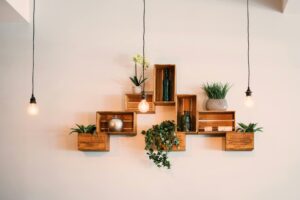In the ever-evolving world of interior design, lighting often plays a pivotal role. It’s more than just a functional element; it’s a statement piece, a mood setter, and a trendsetter. This article delves into the latest lighting trends that are redefining spaces and creating unique atmospheres.
Understanding the Importance of Lighting in Interior Design
Revolutionizing the realm of interior design, lighting continues to shape our spaces in novel and functional ways. This section digs deeper into the dynamic role of lighting in crafting atmospheres and sculpting perception.
The Role of Lighting in Setting the Mood
Present in every space, lighting plays a fundamental role in creating emotional impact. It’s through a careful selection of lighting fixtures and their arrangement that a room can evoke calm, excitement, warmth, or professionalism. For instance, soft, diffused light often introduces a sense of tranquility, highlighting the cozy corners of a living room. In contrast, a powerful spotlight can amplify the drama quotient of a piece of art or a structural element, introducing a sense of excitement.
How Lighting Influences Perception of Space

Lighting’s influence extends beyond mood-setting—it also moulds our perception of space. Broad illumination can make a small room appear larger and more open. As an example, strategic placement of recessed lights in a compact living room can create an illusion of spaciousness. On the contrary, spotlighting in a large room can frame distinct zones, making the space feel more organized and manageable. Thus, manipulating lighting effectively can morph spatial perception, adding an extra dimension to interior design.
Latest Lighting Trends
The turning tides of interior design have brought to the front unique and avant-garde lighting trends. Among these, stand out sustainability, technology, and artistic expression, with each playing a transformative role in the realm of lighting.
Sustainability in Lighting Design
Lighting design has seen a shift towards sustainability, driven by an emphasis on both environmental responsibility and long-term cost savings. Manufacturers have pivoted to energy-efficient lights, such as LEDs, that minimize the environmental footprint and last longer than traditional bulbs. For instance, LEDs can last up to 25 times longer than incandescent lights, an indication of the expansive leap towards sustainability. Moreover, recycled materials are being increasingly utilized to design lighting fixtures, contributing to a smaller ecological footprint. An example is fixtures made from materials like bamboo, glass, and even recycled steel, marking a new era in sustainable design.
Incorporating Technology into Lighting

Technology finds itself deeply entwined with latest lighting trends, bringing a high level of convenience and control. Smart home ecosystems seamlessly incorporate lighting systems that facilitate automation, color temperature adjustment, and even movement detection, offering improved security and energy-efficiency. For instance, Philips Hue Lights offer a myriad of options, from scheduling lights to dim or brighten at particular times, to using motion detectors that turn lights on and off based on room occupancy.
Emphasizing Artistic Expression through Lighting
Expressing creativity and personality through lighting design has gained momentum in the interior design world. Lighting fixtures have become pieces of art, used not just for illumination but also as decorative elements that enhance the aesthetic appeal of a space. Sculptural lighting pieces, statement-making chandeliers, and fixtures with diverse materials and textural finishes exemplify this trend. For example, the Satellite Chandelier by designer Gino Sarfatti takes lighting to an artistic level, transforming what could be a simple lighting fixture into an expressive piece of art.
Practical Tips to Integrate Latest Lighting Trends into Your Space
Let’s delve into some practical tips and techniques that aid in seamlessly integrating the talked-about lighting trends into your space. The tips lead to designing lighting that not only addresses functional needs but also adds artistic expression.
Choosing the Right Light for Your Style
First, choosing light fixtures that reflect your style stands paramount. Identify your style: be it minimalist, industrial, or vintage. Opting for minimalist designs lends your space a simple and clean look. An example embodies geometric pendant lights. On the other hand, an industrial design adds a rough yet modern touch, exemplified by metallic hanging lights. For those craving nostalgia and charm, vintage fixtures such as antique lanterns service a perfect option.
Balancing Function and Aesthetics in Lighting

Balancing function and aesthetics unlocks the full potential of lighting. Opt for a mix of different types of light—ambient, task, and accent—in varying intensities to cater to different needs throughout the day. For instance, a bio-material pendant light gives a room general (ambient) illumination. Pair it with LED strips hidden under kitchen cabinets for task lighting. Add a spotlight to showcase a painting, lending accent lighting, thereby achieving the balance.
Remember to further balance aesthetics by inte+grating your fixtures with the rest of the decor. A Satellite Chandelier, when appropriately placed, can serve as a captivating centerpiece without overshadowing other design elements.
Remember, the key is to strike a balance between style and functionality, ensuring your chosen lighting fixtures reflect your personal taste while meeting your needs. Indeed, the power of lighting in transforming spaces is immense, and it’s exciting to see where these trends will take us next.